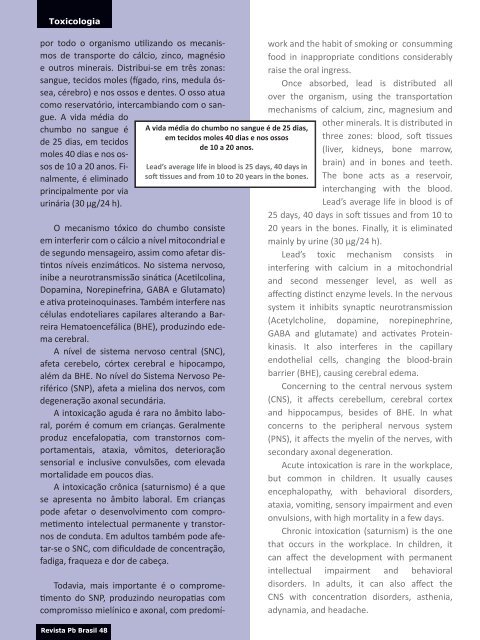edição 10
A Pb Brasil nesta décima edição tem o prazer de apresentar ao seu leitor as ideias, opiniões, conselhos e reflexões de um bom número de especialistas em diversos aspectos que formam a gestão integrada para a saúde ocupacional.
A Pb Brasil nesta décima edição tem o prazer de apresentar ao seu leitor as ideias, opiniões, conselhos e reflexões de um bom número de especialistas em diversos aspectos que formam a gestão integrada para a saúde ocupacional.
You also want an ePaper? Increase the reach of your titles
YUMPU automatically turns print PDFs into web optimized ePapers that Google loves.
Toxicologia<br />
por todo o organismo utilizando os mecanismos<br />
de transporte do cálcio, zinco, magnésio<br />
e outros minerais. Distribui-se em três zonas:<br />
sangue, tecidos moles (fígado, rins, medula óssea,<br />
cérebro) e nos ossos e dentes. O osso atua<br />
como reservatório, intercambiando com o sangue.<br />
A vida média do<br />
chumbo no sangue é<br />
de 25 dias, em tecidos<br />
moles 40 dias e nos ossos<br />
de <strong>10</strong> a 20 anos. Finalmente,<br />
é eliminado<br />
principalmente por via<br />
urinária (30 µg/24 h).<br />
O mecanismo tóxico do chumbo consiste<br />
em interferir com o cálcio a nível mitocondrial e<br />
de segundo mensageiro, assim como afetar distintos<br />
níveis enzimáticos. No sistema nervoso,<br />
inibe a neurotransmissão sinática (Acetilcolina,<br />
Dopamina, Norepinefrina, GABA e Glutamato)<br />
e ativa proteinoquinases. Também interfere nas<br />
células endoteliares capilares alterando a Barreira<br />
Hematoencefálica (BHE), produzindo edema<br />
cerebral.<br />
A nível de sistema nervoso central (SNC),<br />
afeta cerebelo, córtex cerebral e hipocampo,<br />
além da BHE. No nível do Sistema Nervoso Periférico<br />
(SNP), afeta a mielina dos nervos, com<br />
degeneração axonal secundária.<br />
A intoxicação aguda é rara no âmbito laboral,<br />
porém é comum em crianças. Geralmente<br />
produz encefalopatia, com transtornos comportamentais,<br />
ataxia, vômitos, deterioração<br />
sensorial e inclusive convulsões, com elevada<br />
mortalidade em poucos dias.<br />
A intoxicação crônica (saturnismo) é a que<br />
se apresenta no âmbito laboral. Em crianças<br />
pode afetar o desenvolvimento com comprometimento<br />
intelectual permanente y transtornos<br />
de conduta. Em adultos também pode afetar-se<br />
o SNC, com dificuldade de concentração,<br />
fadiga, fraqueza e dor de cabeça.<br />
Revista Pb Brasil 48<br />
A vida média do chumbo no sangue é de 25 dias,<br />
em tecidos moles 40 dias e nos ossos<br />
de <strong>10</strong> a 20 anos.<br />
Lead’s average life in blood is 25 days, 40 days in<br />
soft tissues and from <strong>10</strong> to 20 years in the bones.<br />
Todavia, mais importante é o comprometimento<br />
do SNP, produzindo neuropatias com<br />
compromisso mielínico e axonal, com predomíwork<br />
and the habit of smoking or consumming<br />
food in inappropriate conditions considerably<br />
raise the oral ingress.<br />
Once absorbed, lead is distributed all<br />
over the organism, using the transportation<br />
mechanisms of calcium, zinc, magnesium and<br />
other minerals. It is distributed in<br />
three zones: blood, soft tissues<br />
(liver, kidneys, bone marrow,<br />
brain) and in bones and teeth.<br />
The bone acts as a reservoir,<br />
interchanging with the blood.<br />
Lead’s average life in blood is of<br />
25 days, 40 days in soft tissues and from <strong>10</strong> to<br />
20 years in the bones. Finally, it is eliminated<br />
mainly by urine (30 µg/24 h).<br />
Lead’s toxic mechanism consists in<br />
interfering with calcium in a mitochondrial<br />
and second messenger level, as well as<br />
affecting distinct enzyme levels. In the nervous<br />
system it inhibits synaptic neurotransmission<br />
(Acetylcholine, dopamine, norepinephrine,<br />
GABA and glutamate) and activates Proteinkinasis.<br />
It also interferes in the capillary<br />
endothelial cells, changing the blood-brain<br />
barrier (BHE), causing cerebral edema.<br />
Concerning to the central nervous system<br />
(CNS), it affects cerebellum, cerebral cortex<br />
and hippocampus, besides of BHE. In what<br />
concerns to the peripheral nervous system<br />
(PNS), it affects the myelin of the nerves, with<br />
secondary axonal degeneration.<br />
Acute intoxication is rare in the workplace,<br />
but common in children. It usually causes<br />
encephalopathy, with behavioral disorders,<br />
ataxia, vomiting, sensory impairment and even<br />
onvulsions, with high mortality in a few days.<br />
Chronic intoxication (saturnism) is the one<br />
that occurs in the workplace. In children, it<br />
can affect the development with permanent<br />
intellectual impairment and behavioral<br />
disorders. In adults, it can also affect the<br />
CNS with concentration disorders, asthenia,<br />
adynamia, and headache.<br />
revista junho2014.indd 48 09/06/2014 17:06:22













